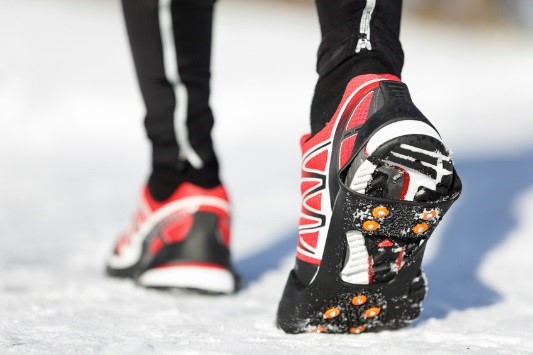
Winter arrives every year and with it comes colder temperatures and changes in the daylight schedule. You don’t have to bring your outdoor workouts inside in the colder months, you just have to take some things into consideration. Here are some tips to keep you moving outside through the colder months:
- Plan ahead – look at the weather report and remember the wind chill is a serious factor. A sunny winter day can be deceiving if the wind brings the cold temperatures to a dangerous level.
- Dress appropriately – layer, layer, layer! Consider 3 layers when exercising in the cold. A base layer should be a moisture wicking material to keep you dry. A mid-layer provides insulation to keep you warm and the outer layer should block wind and repel any water. A zipper is ideal so you can let some cool air in if you begin to feel hot. Be sure to cover your head and hands with appropriate weight hat and gloves/mittens. If conditions are slick, consider putting traction cleats like Yak Tracks on your shoes for added stability.
- Stay hydrated – it’s easy to forget to drink water when you’re not sweating in the heat but it’s easier to dehydrate in the winter as your body has to work harder to humidify the drier winter air.
- Pack a phone – putting your phone in a jacket pocket or a waistband pack provides security in case you need to call for help. If you must listen to something while exercising, consider leaving one earbud out so you can hear and be aware of your surroundings.
- Light yourself up – there’s less sunlight this time of year so if you are trekking out in the dark before sunrise or after sunset, be sure to wear reflective gear and lights. Runners and road cyclists should wear light-colored clothing plus a lighted and/or reflective vest and headlamp to be seen by traffic. A headlamp helps you see potential hazards in your path as well. If cycling, a bike should be outfitted with at least two lights, a headlight and a flashing tail light. Always ride with the flow of traffic and run against the flow of traffic if a sidewalk is not available.
- Warm up – include dynamic warmup exercises before heading out to make sure your muscles are ready for the work. These low intensity pre-workout exercises like leg swings, bodyweight squats, lunges, knee hugs, arm and hip circles get the blood flowing and help prevent injury any time of the year but most especially when it’s cold.
Don’t forget to wear an activity tracker or use your phone to track your steps and link to your N Good Health account. Learn more at www.ngoodhealth.com.
